List of Authors
>>About this blog
Recent blog post
|
[Shitamachi Tom]
December 27, 2013 09:00
It's getting running low this year too. For those who are related to Chuo-ku, various memories will surely be mixed.
 When Christmas is over, we're preparing for the New Year. It's a busy year for cleaning up, preparing New Year's dishes, and busy. And how would you like to spend New Year's Eve? People who are busy preparing for the New Year until the end, those who work during the year-end and New Year holidays, and those who spend a relaxing time ... each day looks back on the year. When Christmas is over, we're preparing for the New Year. It's a busy year for cleaning up, preparing New Year's dishes, and busy. And how would you like to spend New Year's Eve? People who are busy preparing for the New Year until the end, those who work during the year-end and New Year holidays, and those who spend a relaxing time ... each day looks back on the year.
Speaking of New Year's Eve, there are many people who eat "New Year's Eve soba". Originally, "New Year's Eve" means "Setsubun", which means that on this day we prayed for sound health and ate auspicious soba. In the lunar calendar, early spring was the New Year, so the previous day's Setsubun was probably the most important thing. Later, the last day of December became "New Year", and it became established throughout the country with the introduction of the solar calendar. Nowadays, it's a feature of New Year's Eve along with the "bell of night removal".
 Actually, there is another important traditional event on New Year's Eve. This is to visit great exorcism at the shrine. It is an important ceremony that removes everyday filth and entrusts wishes for the New Year together with "Nago Shinohara" on the eve of June. It has been held since the days of Nara and Heian. On this day, we will go through the Chinowa, which will cause trouble, and cleanse ourselves. And they dedicate a doll (persongata) by entrusting them to remove the filth on their behalf. Actually, there is another important traditional event on New Year's Eve. This is to visit great exorcism at the shrine. It is an important ceremony that removes everyday filth and entrusts wishes for the New Year together with "Nago Shinohara" on the eve of June. It has been held since the days of Nara and Heian. On this day, we will go through the Chinowa, which will cause trouble, and cleanse ourselves. And they dedicate a doll (persongata) by entrusting them to remove the filth on their behalf.
In the first place, the meaning of visiting a shrine is to express appreciation for everyday blessing and to remove mistakes and filth of the body. It is said that it is not a sudden wish.
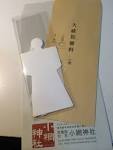 In this sense, great exorcism may be more meaningful than new year worshipping. In this sense, great exorcism may be more meaningful than new year worshipping.
There are also a number of shrines in Chuo-ku that perform this ceremony. In my case, I've been involved in this event at [Nazuki Shrine], [Tetsugunsu Inari Shrine] and [Koami Shrine]. All of them were wrapped in the dignity and strictness cultivated in history and tradition, and I felt somewhat tight.
 Why don't you visit a nearby shrine at the end of the year? Unlike the crowded grounds of new year worshipping, you can visit slowly. Why don't you visit a nearby shrine at the end of the year? Unlike the crowded grounds of new year worshipping, you can visit slowly.
Well, thank you very much for your help this year. I hope you have a good year.
1.
December 24, 2013 14:00
The last show of this year is the Kabukiza Theater. Despite the rough weather as forecast, it is still full today. There is a long line of Makumi. The Kabukiza Theater is performing a Chushingura outward biography this month under the name "Unknown Chushingura," in NovemberChushingura, December and February. There were many performances that were rarely performed, and the day I saw was almost full.
This month's Kabukiza Theater Chushingura is mainly young, and Koshiro and Tamasaburo are closed. In the afternoon, from the introductory to the fourth tier, and in the evening, from the fifth tier to the eleventh tier. (The second and tenth stages are not performed as much as they are now, but there are no eighth or ninth stages.) Ebizo plays a major role with Nao Takashi, Kanpei of Michiyuki, and Heiemon. Mr. Kikunosuke's judge, Mr. Somegoro's Wakasanosuke, the fifth and sixth steps Kanpei and Hanagata actors struggle.
It was reported that Goro Mitsutsu was hospitalized during recuperation, and it was a worried year that he would not be calm as a fan, saying, "What will happen to the attack?" Many people are a little relieved for the first time.
It was still raining when I left the theater while sighing after seeing the "road" of Tamasaburo and Ebizo, who seemed to have no perfect combination of the expression "like a Nishiki-e" was so perfect. It seems that Tokyo was the first snow.
Kabukiza Theater December 25th Senshuraku
Contact Tickethon Shochiku 0570-000-489 (10:00-18:00)
[TAKK...]
December 16, 2013 17:00
A lion statue, a symbol of Mitsukoshi Department Store.
The lion statue is installed at the main entrance of the main building, and it is said that it will celebrate its 100th anniversary next year. Are you friends? I was wearing a trench coat near the entrance of the new building and welcomed customers.
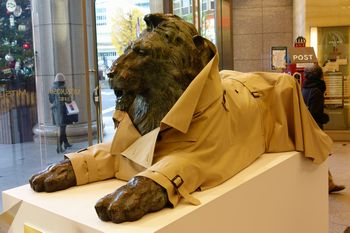
As expected, it is just fit on the body, and the goodness of tailoring and the skill of the craftsman are transmitted.
It seems that Sanyo Shokai was in charge of design and sewing.
I'm going to want such a cool trench coat.
[Apricot peony]
December 11, 2013 09:00
Nanikaichi on the Tsukiji Outer Market has become an annual event.
In December, the 7th was Saturday for the first time in a long time, but it was very crowded, probably because of the influence of the special feature on Tsukiji Market on a popular TV program the day before.
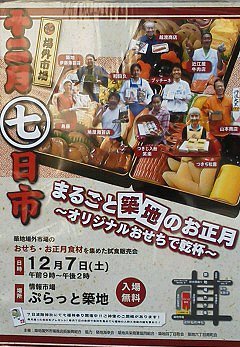 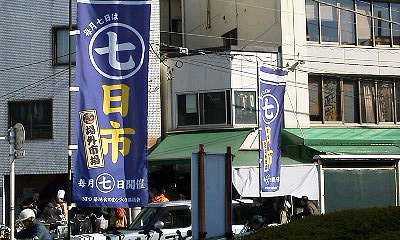
In Nanikaichi, each store offers specialty products at special prices, and at the information center "Platto Tsukiji", unique events unique to Tsukiji, such as eating and comparing eggs, are held every month.
This month of Shiwasu's "Osechi Special Feature"
From the many famous Tsukiji shops, "Matsuro" of egg-yaki, "Irifune" of Kamaboko and Datemaki, char siu from meat Oomiya, and seaweed "Hatoya", which is indispensable for rice cakes, are gathered together. Was.
The small venue was full of many people, as they could sample the specialty products of each store.
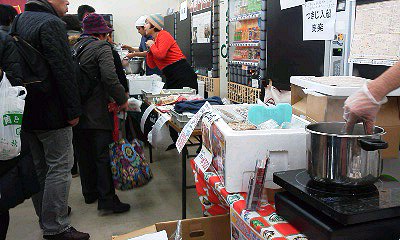 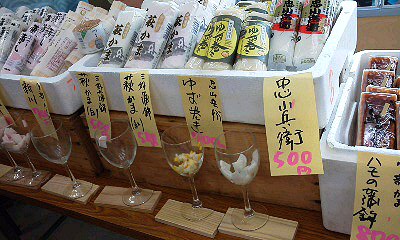
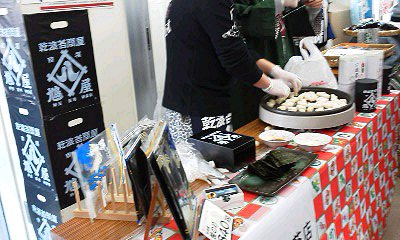 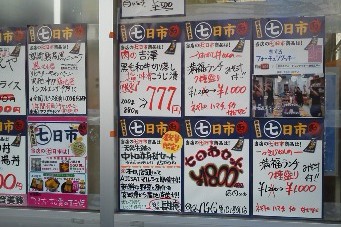
In addition, "Matsuro Sand", which is specially sold at the head office of egg-yaki "Matsuro" in the monthly Nankaichi, is already sold out after 11 o'clock!
In the past, instead of a snack to be covered, the introduction of a slightly unusual sandwich, which recreated that I was eating egg-yaki on bread, was handed over to the next time, so the shop of `` Shoro '' could be lined up Was.
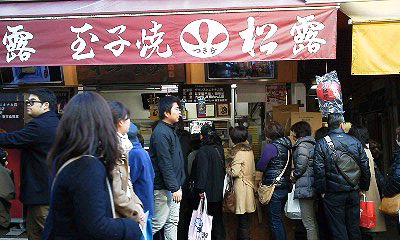
From now on, by the end of the year, more and more people will come and Tsukiji Market will be bustling.
[Ryokichi]
December 6, 2013 14:00
It was Thursday, November 28, but my work was off in the afternoon, so I visited the Doburoku Festival at Koami Shrine.
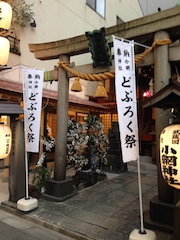
The Doburoku Festival is an event derived from the Niiname-no-Matsuri that appreciates the good harvest of new grains, and the Doburoku is served free of charge after being offered to God. The event will include the dedication of the national important village kagura dance in Intangible Folk Cultural Property, the lucky charm of protection against misfortune, and the award of the Shitamachi Mimizuku.
I was already calm because of the time being out of time, and I visited and had a doburoku. That said, it was a little gorgeous atmosphere in the music.
Koami Shrine is a small shrine located on a small site, but it has attracted attention as a festival in portable shrine in May, a festival in November, and a shrine in Fukurokuju and Benzaiten in Nihonbashi Seven Lucky Gods. It is an indispensable part of annual events around Ningyocho. The small shrine between the buildings has a very interesting structure. In front of the photo below, there is a little shrine hall in the back of the torii gate, a new shrine office on the left, a warehouse on the first floor, and a pentagonal Kagura Hall on the right.
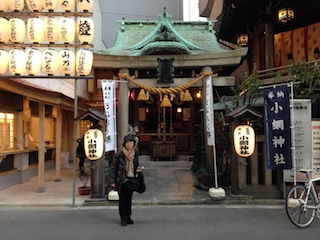
After completing the worship by hooking the doburoku, the downtown shopping street in Ningyocho spreads very close. The weather was so good that the cold had eased, but I felt so relaxed and wanted to stop by. However, it will be a different theme, so I would like to rewrite the times.
[Akira Makibuchi / Sharakusai]
09:00 on December 4, 2013
"Autumn Chuo-ku History Walk 2013-Walking the History of the Old Nikko Kaido-(2nd)" was held on the afternoon of November 30 (Saturday) in fine weather in late autumn. This historical walk visits the history of Nikko Kaido, which laid the foundation for the prosperity of Edo, from Nihonbashi to the site of Asakusa Gomon. Following the first half of the first half (November 16), the second half of the second half walked from the site of Temmacho prison to the site of Asakusa Gomon.
The recruitment of participants was recruited in the November 1 issue of the "News of the Ward" and was sponsored and implemented by the "Chuo-ku Cultural Properties Supporters Association", a town walking volunteer guide group.
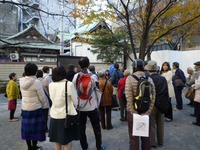 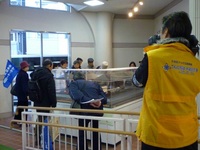
The number of participants who gathered at Jisshi Park reached the capacity of 30 people and departed in two groups (left photo). After observing a model of the Temmacho prison house at the Chuo-ku Machikado Exhibition Hall in Jushi Square (right photo = receiving TV coverage) and then look around the monument of the end of Yoshida Shoin in the park and the bell of Kokumachi. The road north of Daidenma Honcho-dori St. is the old Nikko Kaido. On both sides of the street are the former Tsunango-cho, and there was a Daimaru kimono store in the southeast corner crossing Daimon-dori until the late Meiji era.
Beyond that, the female scriptwriter Shigure Hasegawa was born and raised in the former Yuyu town. The Koshodo of Juzaburo Tsutaya has a shop facing the highway, and an explanation board is currently installed. In front of the diagonally, there is Tsuruya, a bookstore in Kyoto depicted in the Edo Famous Zoukai, and it is the area where the local wholesalers lined up. The fact that there were many hardware stores around here is detailed in Shigure Hasegawa's "Old Mon Nihonbashi". Even today, there are hardware companies from the Edo period.
After crossing the Hamacho River ruins, you will enter Yokoyamacho. It is the scenery of a wholesaler town where crowds are more crowded than usual before the end of the year. From the Bakurocho intersection, walk along Edo-dori St. During the Edo period, it was also an area where public and inns were lined up, and its bustle may have been the starting point of today. Further further, to the west, there is the ruins of the Baba of Hatsune. It is the oldest Baba, which is said to have been sold by Ieyasu, and has been featured in "Hundred Views of Edo" and "Edo Famous Zoukai".
There was a county mansion next to it. Litigators from Kanpachi came here. It is said that public inns and shops gathered in Bakurocho, and even a tourist information center for a four-day tour of Edo sightseeing appeared. When you follow the ruins of the Gundai mansion, you will notice a complicated path. Yasukuni Dori was built in the Great Kanto Earthquake Reconstruction Project and the block changed. Why was the border around here bent? It's a place to unravel. In this area, the site of the Gundai mansion was bordered by the ward.
Along the ruins of Yanagihara embankment, head to Saemon Bridge. This bridge over the Kanda River borders Chuo-ku, Chiyoda-ku, and Taito-ku. It is the northernmost part of Chuo-ku. Asakusa Gomon was placed in front of Asakusabashi. It was the last gate of the Edo Castle area when heading to Tohoku along the Nikko Kaido. Is it related to the fact that there is a police box near the Obansho at that time? It will be dissolved at the Asakusa Mitsuke Ruins Monument on the west side of Kitazume across Asakusabashi. @ Akira Makibuchi
◇The pattern of the town walk of the day, Chuo-ku TV public information "Hello Chuo-ku", is scheduled to be broadcast in the second week of December.
|
Links
|
 When Christmas is over, we're preparing for the New Year. It's a busy year for cleaning up, preparing New Year's dishes, and busy. And how would you like to spend New Year's Eve? People who are busy preparing for the New Year until the end, those who work during the year-end and New Year holidays, and those who spend a relaxing time ... each day looks back on the year.
When Christmas is over, we're preparing for the New Year. It's a busy year for cleaning up, preparing New Year's dishes, and busy. And how would you like to spend New Year's Eve? People who are busy preparing for the New Year until the end, those who work during the year-end and New Year holidays, and those who spend a relaxing time ... each day looks back on the year. Actually, there is another important traditional event on New Year's Eve. This is to visit great exorcism at the shrine. It is an important ceremony that removes everyday filth and entrusts wishes for the New Year together with "Nago Shinohara" on the eve of June. It has been held since the days of Nara and Heian. On this day, we will go through the Chinowa, which will cause trouble, and cleanse ourselves. And they dedicate a doll (persongata) by entrusting them to remove the filth on their behalf.
Actually, there is another important traditional event on New Year's Eve. This is to visit great exorcism at the shrine. It is an important ceremony that removes everyday filth and entrusts wishes for the New Year together with "Nago Shinohara" on the eve of June. It has been held since the days of Nara and Heian. On this day, we will go through the Chinowa, which will cause trouble, and cleanse ourselves. And they dedicate a doll (persongata) by entrusting them to remove the filth on their behalf. In this sense, great exorcism may be more meaningful than new year worshipping.
In this sense, great exorcism may be more meaningful than new year worshipping. Why don't you visit a nearby shrine at the end of the year? Unlike the crowded grounds of new year worshipping, you can visit slowly.
Why don't you visit a nearby shrine at the end of the year? Unlike the crowded grounds of new year worshipping, you can visit slowly.











